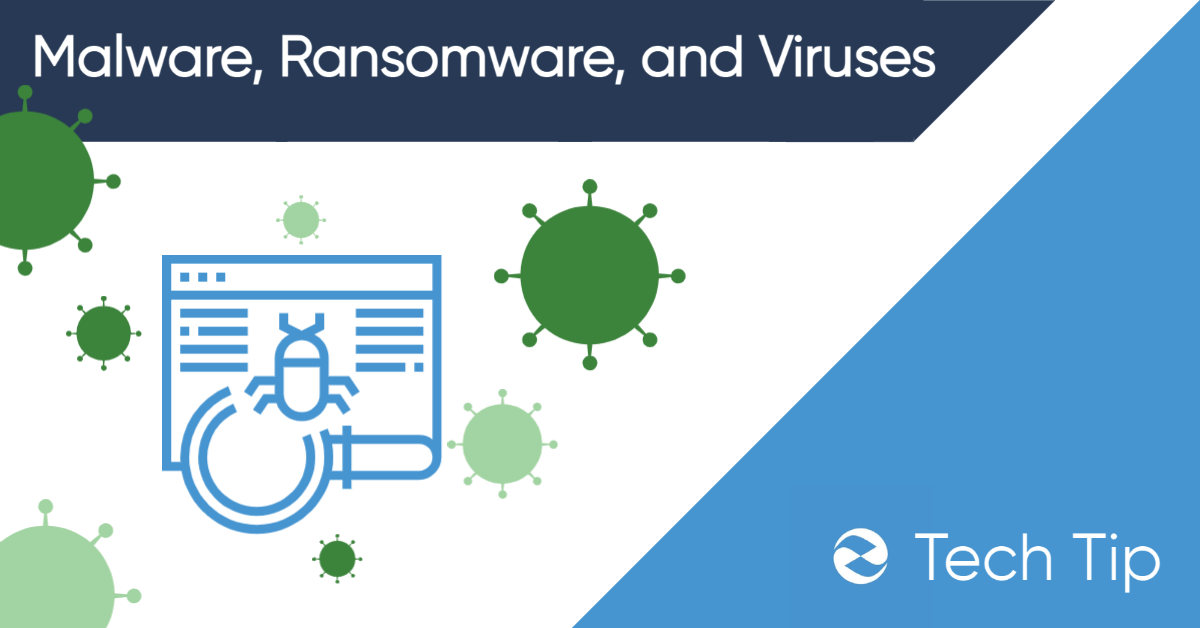A Brief Guide on The Differences Between Malware, Ransomware, and Viruses

Viruses, ransomware, and malware are all malicious software programs that can harm your computer. Being able to identify types of malicious software will help you protect your system. This article will define ransomware, viruses, and malware. We’ll also cover how each spreads and what their different goals are.
Definitions
Malware
Malware is an umbrella term for any malicious software that can infect a system. Spyware, virus, ransomware, etc are all malware.
Virus
A virus is a program that can spread from computer to computer through the insertion of its code into other programs. Viruses are designed to attach themselves to certain types of files, such as document or executable files. When you open up one of these infected documents or executables on your system, the virus that is latched on is triggered and begins to replicate itself on the system.
Ransomware
Ransomware is a type of malware that holds your data hostage and demands money in return for unlocking it. Ransomware attacks involve an attacker locking down the victim’s system, preventing them from opening or modifying files till they pay.
Ransomware generally seeks to encrypt files and prevent them from being modified. But sometimes ransomware can steal the victim’s credentials or buy time for a criminal to snoop deep within your system.
Spyware
Spyware is malware that monitors the victim’s activities and sends this information to attackers. Spying activity often includes reading messages, recording browsing history, or viewing the user through a webcam.
Crypto Miner
Crypto miners are software that is installed for the express purpose of mining cryptocurrency without the user’s permission or knowledge. Telltale signs include the system running very hot or loud, using more resources than is sensible, experiencing rapid hardware degradation.
How Malware Spreads
There are common ways that malware spreads. And although malware can sometimes spread in unconventional ways, these methods are what to be cautious of.
Email: Emails can contain malicious files or pictures that when opened or downloaded begin the replication process on the local machine.
Stolen Credentials: Should your machine’s credentials become compromised, a hacker can gain access to it and install a malicious program or code on it.
Illegitimate download: If you download content from untrustworthy sources there is a high chance you will infect your system with a virus.
URL redirect: Sometimes a legitimate site’s DNS can be hijacked and lead a user to a page with a download that looks legitimate. Be on the lookout for sudden URL changes when clicking “download”.
Network infection: If a system has already been infected and is connected to others via the network, it can infect other systems.
Phishing email: An email that often poses as legitimate from a trusted sender that asks you for credentials or to download a malicious program that begins the encryption process.
RDP Exploit: A system open via RDP ports can be remotely hacked after a hacker correctly guesses system credentials. The hacker then manually installs ransomware.
Sabotage: Those that seek harm like a disgruntled employee can commit sabotage by logging in and infecting systems they have already been trusted to operate within.
What can you do to protect your system?
Getting infected with malware (especially ransomware) can cause serious problems for your machine, business, mental health, and finances. Luckily, protecting your system is very easy. Follow as many of these tips as you can.
- open emails with caution, you can even get a disclaimer that notifies if an email sender originates outside your organization if it helps. Pay special attention to the sender’s email domain.
- do not open links from untrusted sources
- always double-check the URL or domain of the site you are on to make sure it’s authentic.
- use antivirus software that has been proven to be effective against malware and ransomware. Some are even free or low cost like Malwarebytes.
- Use anti-ransomware tools like Zebra Ransomware Stopper to stop ransomware if it has already infected your system.
- If a company calls and asks for anything, hang up and call back on the official support line to make sure it’s a legitimate question from the business. A business will never ask for credentials like username and password over the phone.
- lockdown systems that do not need regular RDP access
- change credentials as often as possible (once a quarter is typical)
- implement 2FA
- regularly monitor servers and other systems to make sure there is no irregular activity.
- Make sure to use robust backups (learn how to do it right - link)
Summary
Although malware, ransomware, and virus are terms used interchangeably they are not the same thing. Malware is simply an umbrella term for malicious software, and the more specific types of malicious software each have their own goal.
Hopefully, this guide helped you learn the differences between different types of malware, how they can affect you or your business, and a few simple tips to protect your system.
The Changing Face of Ransomware
Out of all types of malware, ransomware is arguably the type that is adapting most rapidly. Ransomware is innovating and finding new ways to target you so we prepared this article so you can learn about the Changing Face of Ransomware.